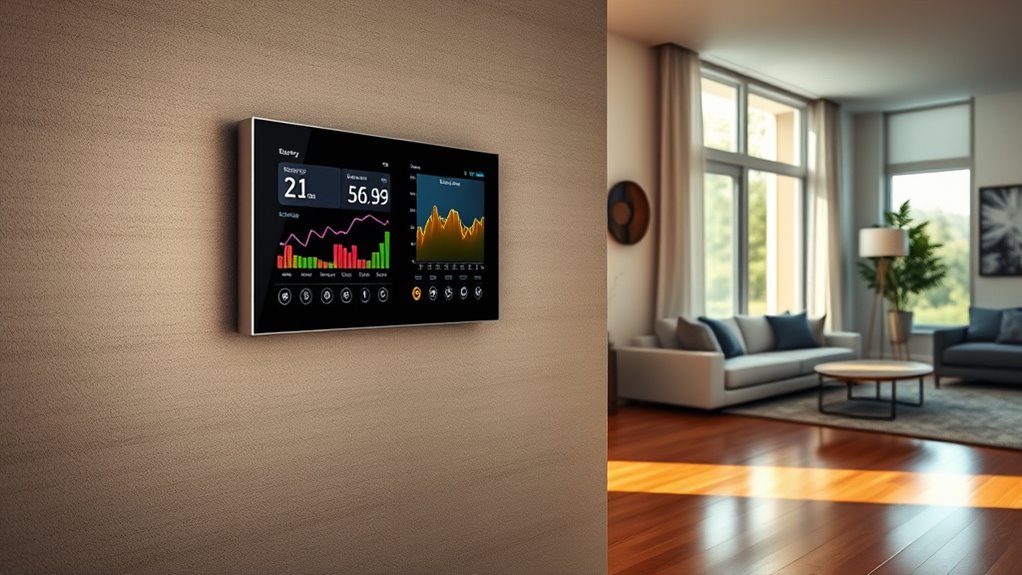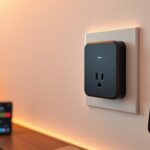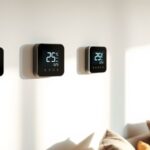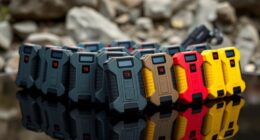If you want to save money and boost your home’s efficiency, I recommend exploring the top whole-house energy monitors like Emporia Vue 3, Sense, and Flex. These devices offer real-time data, circuit-level insights, and smart automation to help you understand your energy use better. They are safe, easy to install, and compatible with various electrical setups. Keep going to discover detailed features and tips on choosing the right monitor for your needs.
Key Takeaways
- Look for monitors with high accuracy (±2%) and real-time data for precise energy tracking.
- Choose models supporting multiple circuits and electrical configurations for comprehensive house monitoring.
- Prioritize devices with smart integrations, automation, and alerts to optimize energy savings.
- Ensure compatibility with your electrical system and easy installation options like clamp-on sensors.
- Consider cloud storage limits and long-term data capabilities for ongoing energy management and cost analysis.
Emporia Vue 3 Home Energy Monitor
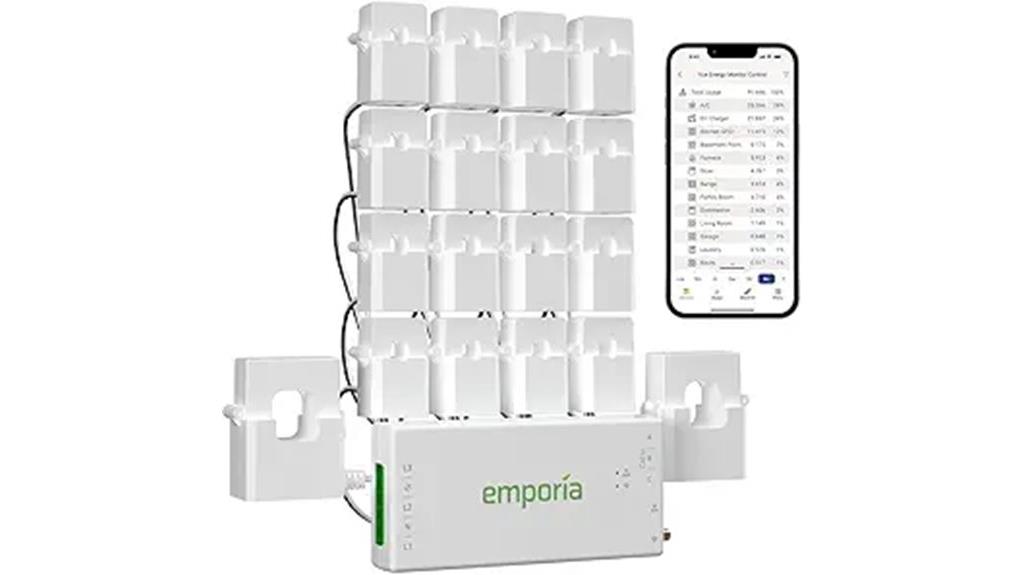
The Emporia Vue 3 Home Energy Monitor stands out for its extensive safety certifications and easy installation, making it an excellent choice for homeowners who want a reliable and safe energy monitoring system. It’s UL Listed, meeting strict safety standards in the U.S. and Canada, with certified components that prevent hazards like overheating or fires. Installation is straightforward, using clamp-on sensors within the circuit panel, compatible with various systems including single-phase and 3-phase setups. Enhanced screw terminals make wiring tidy and simple. Overall, it combines safety, ease of use, and reliable data collection to help you monitor and optimize your home’s energy use effectively.
Best For: homeowners seeking a safe, reliable, and easy-to-install energy monitoring system that provides real-time data and supports various electrical configurations.
Pros:
- UL Listed and CE certified, ensuring high safety standards and peace of mind
- Simple clamp-on installation compatible with multiple system types, including single-phase and 3-phase setups
- Accurate energy data collection with ±2% precision and real-time monitoring capabilities
Cons:
- Additional 200A sensor required for certain 3-wire, 3-phase, 4-wire Wye systems, which is sold separately
- Cloud storage retention limited to 7 days for minute data, requiring export for long-term storage
- May require a stable 2.4 GHz Wi-Fi connection for optimal performance and remote monitoring
Smart Home Energy Monitor with 16 50A Circuit Level Sensors

If you’re looking for an exhaustive energy monitoring solution for your home, the Smart Home Energy Monitor with 16 50A circuit-level sensors is an excellent choice. It offers real-time, highly accurate measurements (within 1.5%) across single-phase, split-phase, and three-phase systems. Installing is straightforward with clamp-on sensors suitable for most panels, and it supports local or cloud-based operation, including MQTT integration for privacy. The accompanying app displays detailed data, alerts, and energy trends, making it easy to identify high consumption areas. Overall, it provides comprehensive monitoring, flexible setup, and seamless smart home integration for better energy management.
Best For: homeowners seeking comprehensive, highly accurate energy monitoring and smart home integration for cost savings and energy efficiency.
Pros:
- High accuracy measurements within 1.5%, verified with utility data
- Supports a wide range of electrical systems (single, split-phase, three-phase)
- Flexible installation options with clamp-on sensors, ideal for tight panels
Cons:
- No knockout grommet available for WiFi antenna installation
- Requires some familiarity with MQTT and YAML for advanced customization
- No support for Delta three-phase systems, limiting certain industrial applications
Smart Home Energy Monitor with Circuit Sensors and Real-Time Usage Tracking
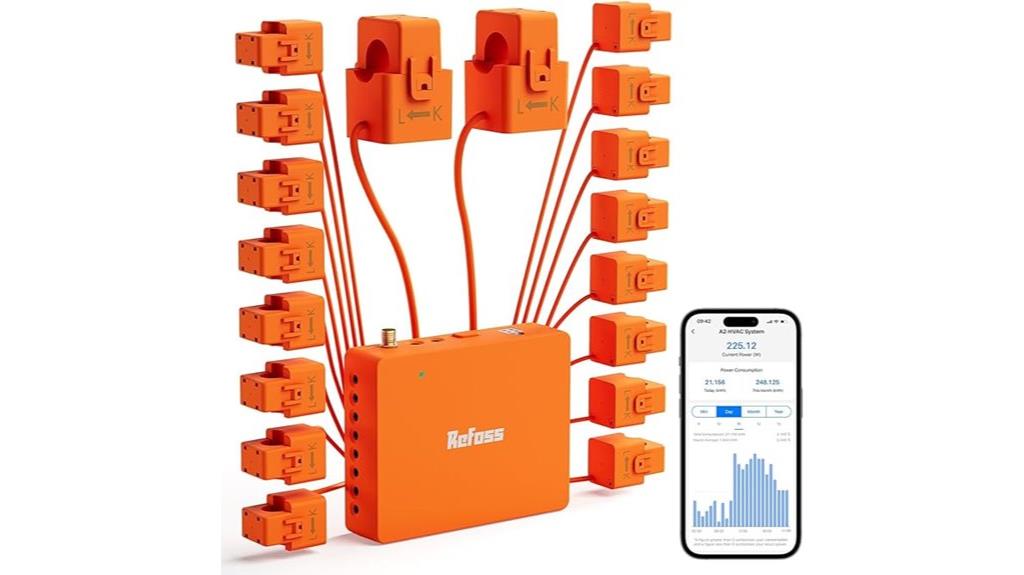
For homeowners seeking precise, real-time insights into their energy consumption, the Refoss EM16 Smart Home Energy Monitor stands out thanks to its extensive circuit sensors and seamless integration with home automation systems. It supports various electrical setups, including single-phase and three-phase systems, and can monitor up to 16 branch circuits with high accuracy. Installation is straightforward with clamp-on sensors, though some electrical knowledge is helpful. The device provides continuous data on power, current, voltage, and power factor, which you can track via the app. It also supports solar integration and automation, helping reduce bills and maximize solar energy use effectively.
Best For: homeowners and solar energy enthusiasts seeking detailed real-time energy monitoring, automation integration, and long-term data analysis for their electrical systems.
Pros:
- Supports a wide range of electrical system types including single-phase and three-phase setups with high sensor accuracy.
- Seamless integration with home automation platforms like Home Assistant for centralized control and automation.
- Stores up to 3 years of detailed energy data, enabling thorough analysis and informed energy management.
Cons:
- Installation involves working inside breaker panels, which may require professional electrician assistance for safety.
- Cable management can be challenging in crowded panels, and wiring clutter may affect neatness.
- Lacks an API for external integrations beyond the supported platforms, limiting customization options.
Sense Energy Monitor, Real-Time Electricity Tracking and Safety Certified
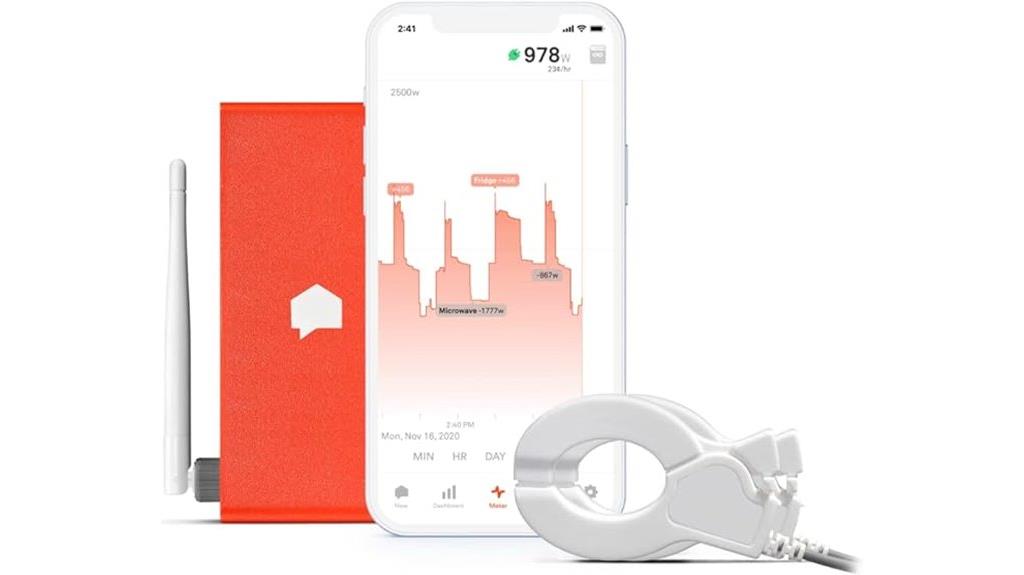
Sense Energy Monitor stands out for homeowners who want real-time insights into their household electricity use, helping them conserve energy and reduce bills. It tracks power consumption instantly, supports time-of-use plans, and recognizes patterns to identify devices. Compatible with iOS, Android, and web apps, it allows remote monitoring. Safety-certified by ETL/Intertek, it’s designed for installation inside electrical panels—mainly in North America. While it offers valuable data, some users report accuracy issues with complex or similar appliances. Still, its real-time tracking and safety standards make it a solid choice for those willing to ensure proper installation and manage expectations.
Best For: homeowners in North America seeking real-time energy insights and device recognition to monitor and reduce their household electricity consumption.
Pros:
- Supports real-time electricity tracking and pattern recognition for device identification
- Compatible with iOS, Android, and web apps for remote monitoring
- Safety-certified for installation inside electrical panels, meeting strict safety standards
Cons:
- Accuracy issues with complex or similar appliances, leading to unreliable device detection
- Installation may require electrical expertise or professional assistance, especially outside North America
- Limited data export options and difficulty adjusting billing periods or detailed analysis
Sense Flex Home Energy Monitor
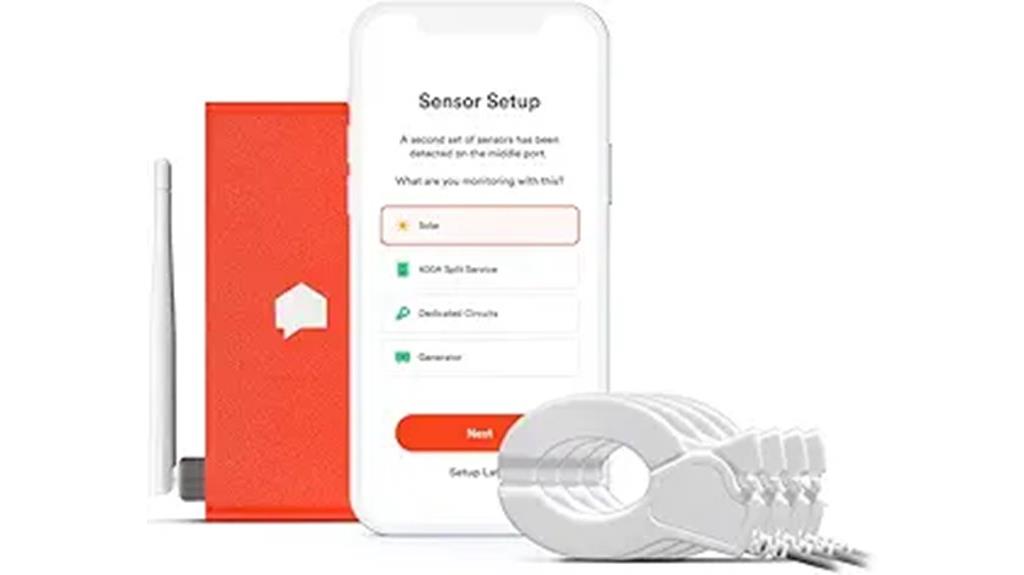
The Sense Flex Home Energy Monitor stands out for homeowners who want to monitor multiple circuits or integrate renewable energy sources like solar and generators seamlessly. It combines the Sense monitor with Flex sensors, allowing you to track up to two 120V/240V circuits, solar systems, generators, or 400A split-service setups. This flexibility gives a all-encompassing view of your energy use across different sources. Available only in the U.S. and Canada, it provides detailed insights, supports time-of-use rates, and helps optimize your energy consumption. With real-time data and customizable alerts, the Sense Flex makes managing your home’s energy smarter and more efficient.
Best For: homeowners in the U.S. and Canada seeking comprehensive energy monitoring for multiple circuits, renewable energy sources, and real-time insights to optimize home energy use.
Pros:
- Supports monitoring of up to two 120V/240V circuits, solar, generator, or split-service systems for a holistic view of energy consumption
- Provides detailed insights and automatic device detection to improve energy efficiency and security
- Compatible with real-time apps and customizable notifications to prevent critical device failures
Cons:
- Available only in the U.S. and Canada, limiting access for international users
- Requires installation of Flex sensors, which may involve some technical setup
- Does not currently support integration with smart home platforms beyond energy monitoring apps
Smart Home Energy Monitor with 2 CTs

If you’re looking to optimize your home’s energy usage with precise monitoring, the Smart Home Energy Monitor with 2 CTs stands out as an ideal choice for those managing solar or battery storage systems. It comes with two 120A split-core CTs, supports single-phase 3-wire systems, and connects via WiFi. This monitor provides real-time data on voltage, current, power, and energy, with Class 1 accuracy. It supports features like dynamic load balancing and zero grid export mode, and integrates seamlessly with the Smart Life app. Installation is straightforward, with pluggable terminals and compact design, making energy management simple and efficient.
Best For: homeowners with solar or battery storage systems seeking precise, real-time energy monitoring and smart home integration.
Pros:
- Supports single-phase 3-wire systems with Class 1 accuracy for reliable measurements.
- Easy installation with pluggable terminals and compact split-core CTs, requiring no complex wiring.
- Seamless integration with the Smart Life app for real-time data, alerts, and automation scenes.
Cons:
- Limited to WiFi connectivity on the 2.4GHz band, which may be prone to interference.
- Only supports single-phase systems; not suitable for three-phase setups.
- Customer reviews are moderate, with an average rating of 4.1/5 stars, indicating some users may experience setup or functionality issues.
Emporia Energy Monitor with Sensors and Smart Plugs Bundle
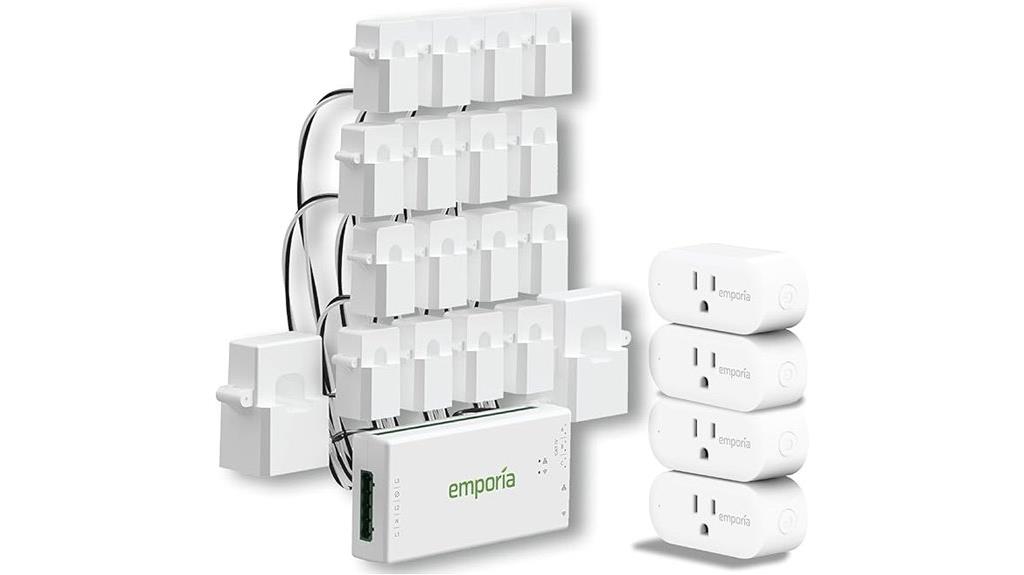
For homeowners seeking extensive energy oversight with smart control, the Emporia Energy Monitor with Sensors and Smart Plugs Bundle stands out as an excellent choice. It tracks electricity from the main panel and up to 16 circuits in real time, giving you detailed insights into your home’s consumption. The bundle includes four Wi-Fi smart plugs, allowing remote control and automation of individual devices, helping reduce standby power waste. The free Emporia app makes it easy to monitor usage, set schedules, and access data securely in the cloud. With support for solar net metering and customizable automation, this system helps cut costs and boost energy efficiency effortlessly.
Best For: homeowners and energy enthusiasts seeking comprehensive real-time energy monitoring, remote device control, and automation to improve efficiency and reduce costs.
Pros:
- Tracks electricity usage from main panel and up to 16 circuits for detailed insights
- Includes 4 Wi-Fi smart plugs for remote control and automation of devices
- Supports solar net metering and customizable automation for cost savings
Cons:
- Requires Wi-Fi connection for optimal functionality and automation
- May involve a learning curve for setup and integration of multiple sensors and devices
- Limited to 16 circuits, which might not cover very large or complex electrical systems
SIEMENS Inhab Smart Home Energy Monitor
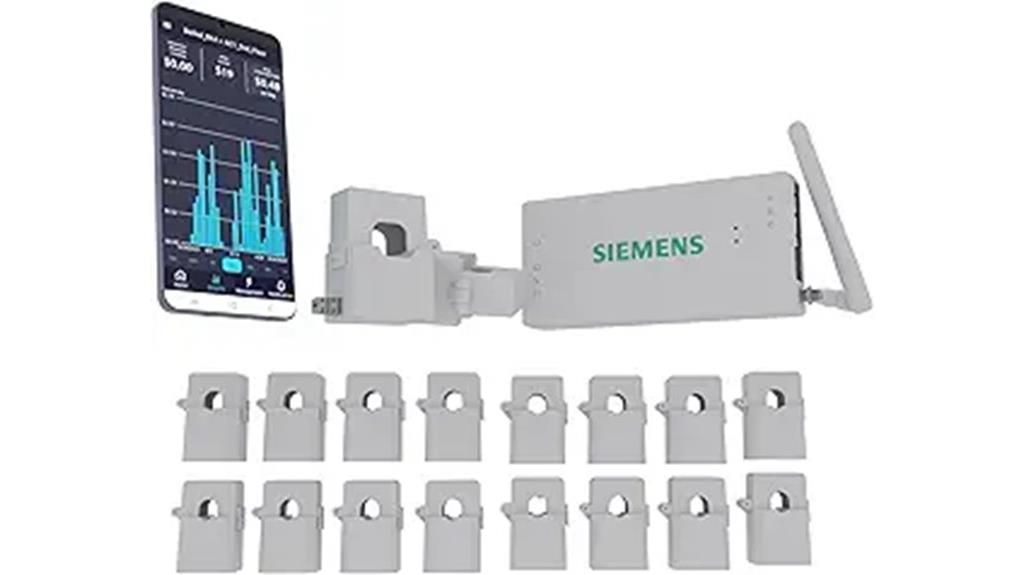
Designed for homeowners seeking precise, real-time energy monitoring, the SIEMENS Inhab Smart Home Energy Monitor stands out with its 16-50Amp circuit sensors and 2-200Amp main sensors. It measures energy consumption directly at the panel mains and up to 16 branch circuits, providing detailed load data without estimates. Compatible with both new and existing panels, it offers exhaustive whole-home and circuit-level insights. The accompanying mobile app lets me track usage 24/7, set alerts for abnormal activity or savings opportunities, and manage energy more effectively. Its advanced features, including Time of Use and Peak Demand management, help boost efficiency and cut costs, all while meeting rigorous safety standards.
Best For: homeowners seeking precise, real-time energy monitoring and advanced energy management features to optimize usage and reduce costs.
Pros:
- Provides detailed load data at panel mains and multiple circuits without estimation.
- Compatible with both new and existing electrical panels, making installation flexible.
- Offers comprehensive mobile app control with customizable alerts and advanced energy management tools.
Cons:
- May require professional installation due to electrical panel integration.
- Limited to the USA and Canada in terms of app support and functionality.
- Advanced features like load shedding and peak demand management may need compatible smart devices or additional setup.
Home Energy Monitor with WiFi or Ethernet
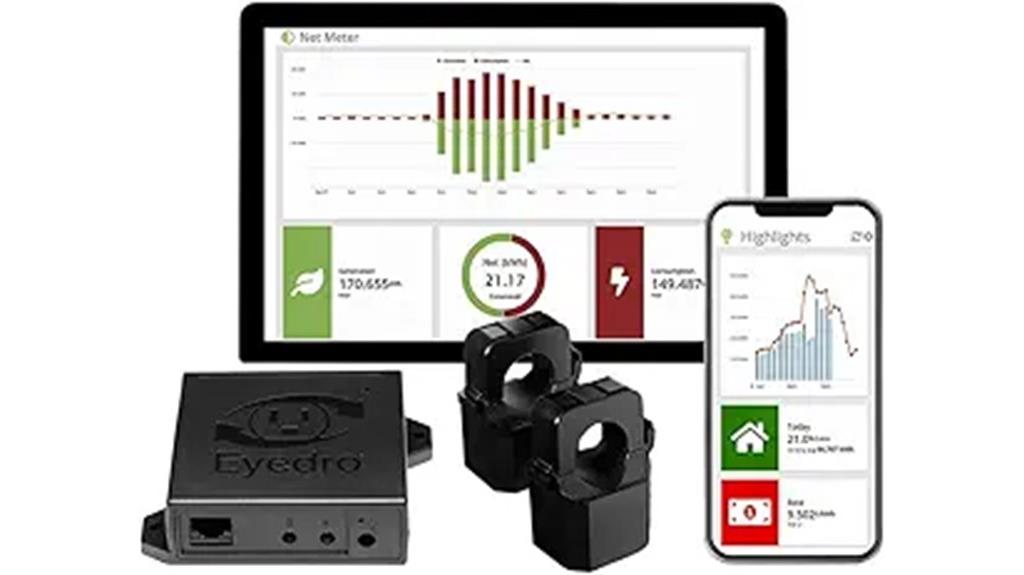
A home energy monitor with WiFi or Ethernet is ideal for those who want real-time, remote access to their energy usage data. I find these monitors incredibly helpful because they let me track electricity, solar, and grid consumption from anywhere using my smartphone or computer. The EYEDRO-HOME model supports both Ethernet and WiFi connections, making setup flexible. It displays detailed info like watts, volts, amps, and costs, helping me identify energy spikes and optimize usage. With features like bill comparisons and notifications, I can easily manage my energy habits to save money and maximize solar benefits—all without a subscription fee.
Best For: homeowners and energy-conscious individuals seeking real-time remote monitoring of their electricity, solar, and grid usage via WiFi or Ethernet.
Pros:
- Supports both WiFi and Ethernet connections for flexible setup options
- Provides detailed real-time and historical data on power consumption and costs
- No subscription fee, with features like bill comparisons and notifications
Cons:
- Requires a compatible North American power supply (120VAC), limiting use in other regions
- May need technical knowledge for installation and troubleshooting
- Limited to North American power standards and may not support international voltages
Emporia Vue 3 Commercial 3-Phase Energy Monitor

The Emporia Vue 3 Commercial 3-Phase Energy Monitor stands out as an ideal choice for small businesses and advanced home automation enthusiasts who need accurate, real-time electricity monitoring across multiple circuits. It installs easily in circuit panels using clamp-on sensors, supporting various electrical systems, including single-phase and 3-phase setups. With 16 circuit sensors, it provides detailed insights into energy use. Weighing just over five pounds, it’s a robust, hardwired device designed for continuous monitoring, compatible with solar and net metering applications. Rated 4.6 out of 5 stars, it’s a reliable tool to help save money and boost efficiency.
Best For: small businesses and advanced home automation enthusiasts seeking accurate, real-time energy monitoring across multiple circuits.
Pros:
- Supports various electrical systems, including single-phase and three-phase setups.
- Equipped with 16 circuit sensors for detailed energy consumption insights.
- Easy installation with clamp-on sensors and a robust, hardwired design.
Cons:
- Additional 200A sensor required for 3-phase, 4-wire wye systems with earthed neutral.
- No batteries included; relies on hardwired power source.
- Slightly heavy at over five pounds, which may affect mounting options in some panels.
Upgraded Watt Power Meter Plug for Home Electrical Monitoring
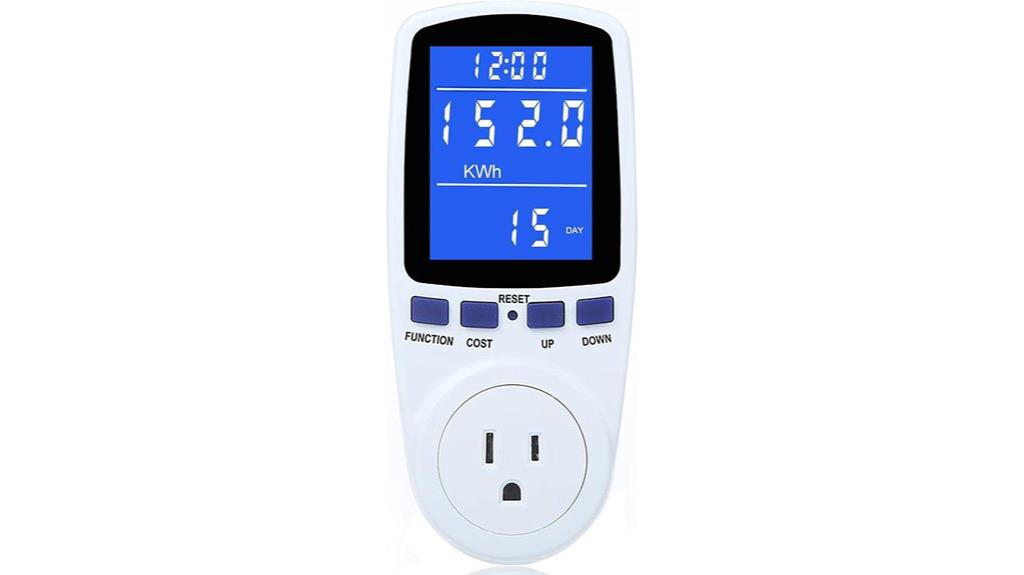
If you’re looking to easily track and manage your home’s energy consumption, the upgraded Watt Power Meter Plug stands out as an excellent choice. It monitors key parameters like power (W), energy (kWh), volts, amps, and power factor, displaying estimated bills and usage stats across 7 modes. The large, backlit LCD ensures clear readings anytime, and its wide viewing angle adds convenience. With overload protection and adjustable thresholds, it keeps your appliances safe. Plus, its memory function records data even during power outages, helping you identify energy patterns over time. This device is highly rated, compact, easy to use, and requires no batteries, making energy monitoring straightforward.
Best For: homeowners and energy-conscious individuals seeking an easy, accurate way to monitor and manage their household electricity consumption and costs.
Pros:
- Large, backlit LCD screen with wide viewing angles for clear visibility day and night
- Overload protection with adjustable thresholds to ensure appliance safety
- Memory function that retains data during power outages, supporting long-term energy tracking
Cons:
- Requires careful setting of overload threshold to avoid false warnings or missed overloads
- No batteries needed, but reliance on corded power may limit placement options
- The device’s features and display may be complex for some users unfamiliar with electrical parameters
Sense Energy Monitor with Solar
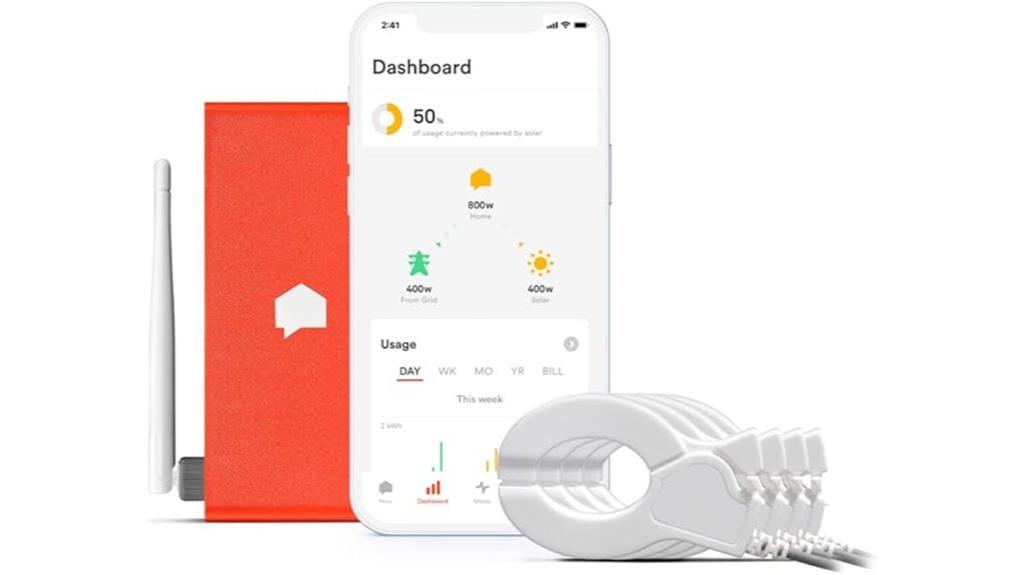
For homeowners with solar panels seeking to maximize their energy savings, the Sense Energy Monitor with Solar offers an all-inclusive solution. It tracks real-time electricity usage and solar production, giving you detailed insights to optimize your energy use. The device compares solar generation and consumption side-by-side, helping you make the most of your solar power and reduce costs. With features like device activity alerts and custom notifications for critical equipment, it enhances home security and efficiency. Powered by sensors inside your electrical panel, it’s safe, reliable, and designed for US and Canadian homes. This monitor empowers you to save money and boost your energy efficiency effortlessly.
Best For: homeowners with solar panels in the US or Canada seeking to optimize their energy savings and monitor both consumption and solar production in real-time.
Pros:
- Provides detailed real-time insights into energy usage and solar generation side-by-side.
- Supports custom notifications for critical devices, enhancing home security and disaster prevention.
- Easy to install inside electrical panels with safety certifications for US and Canadian standards.
Cons:
- Only compatible with electrical systems in the US and Canada, limiting international use.
- Does not include batteries, so it relies solely on wired power, which may require professional installation.
- Customer rating of 3.8 stars suggests some users may experience issues with setup or app functionality.
Upgraded Watt Meter Power Meter Plug for Home Energy Monitoring
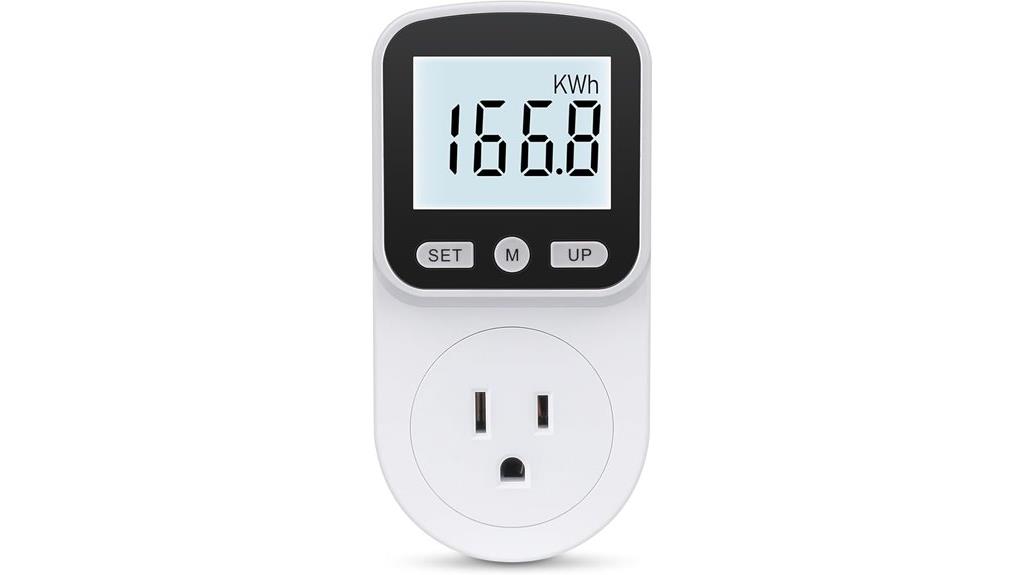
Anyone looking to keep a close eye on their household energy use will find the upgraded Watt Meter Power Meter Plug an essential tool. It measures important electrical parameters like power, voltage, current, and even total cost, making it easy to track appliance efficiency. Its 8 display modes help you monitor different data points during operation, including electricity consumption and cumulative bills. Made from durable, fire-resistant materials, it features overload protection and a clear backlit LCD screen. The device saves data even when unplugged, helping you identify energy hogs and save money over time. It’s simple to use and compatible with all US appliances, making energy management straightforward.
Best For: homeowners and energy-conscious individuals seeking an easy-to-use device to monitor and manage household electricity consumption and costs.
Pros:
- Provides comprehensive monitoring of electrical parameters including power, voltage, current, and total cost.
- Durable, fire-resistant ABS construction with overload protection ensures safety and longevity.
- Saves energy data even during power outages, enabling long-term tracking and cost management.
Cons:
- May be less suitable for non-US appliances due to US socket compatibility.
- The LCD backlight turns off automatically after 10 minutes, which might require manual adjustment for continuous visibility.
- No batteries are included, so continuous operation depends on being plugged into an AC power source.
Business 3-Phase Energy & Solar Monitor
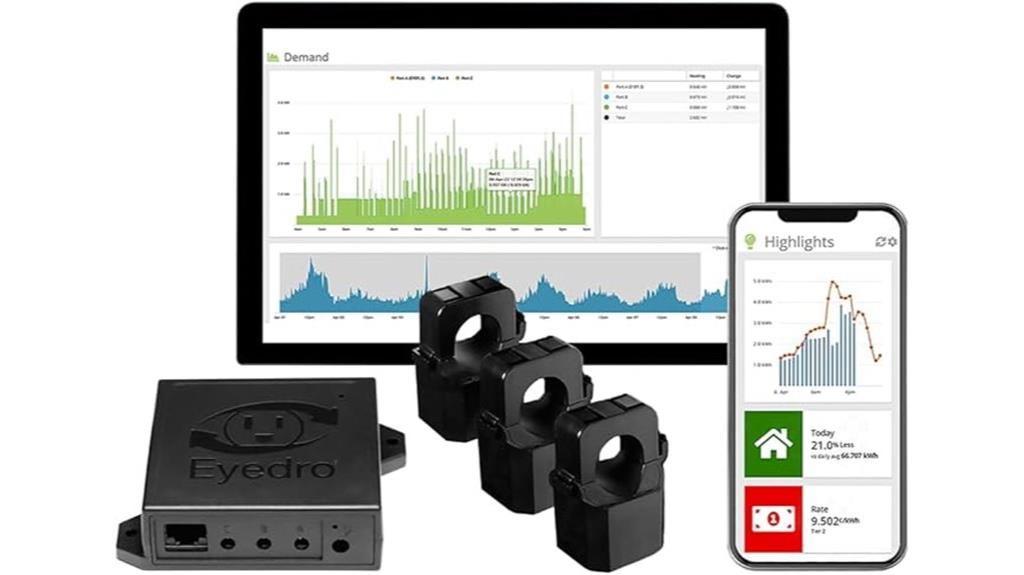
The Business 3-Phase Energy & Solar Monitor stands out as an ideal choice for commercial or multi-tenant properties that require detailed energy management across three-phase systems. It supports various voltage configurations, including 600V Delta and 480V Wye, making it versatile for grid and solar setups. With WiFi and Ethernet connectivity, it offers real-time, high-resolution data on power consumption, solar generation, and costs. The device’s non-invasive split-core sensors simplify installation, and its compatibility with cloud software provides extensive insights into energy use, peak demands, and savings opportunities. It’s perfect for optimizing energy efficiency and managing utility expenses in complex electrical environments.
Best For: commercial property managers and multi-tenant facilities seeking comprehensive, real-time energy and solar monitoring for three-phase electrical systems.
Pros:
- Supports multiple voltage configurations suitable for diverse grid and solar setups.
- Non-invasive, split-core sensors allow easy installation without electrical panel disruption.
- Cloud platform provides detailed, real-time insights, alerts, and customizable energy reports.
Cons:
- May require technical knowledge for optimal setup and interpretation of data.
- Limited to 600V AC power ratings, which could restrict use in higher-voltage environments.
- The device’s size and weight might be less suitable for tight or concealed installation spaces.
AC Power Monitor with LCD Display and Split Core Current Transformer
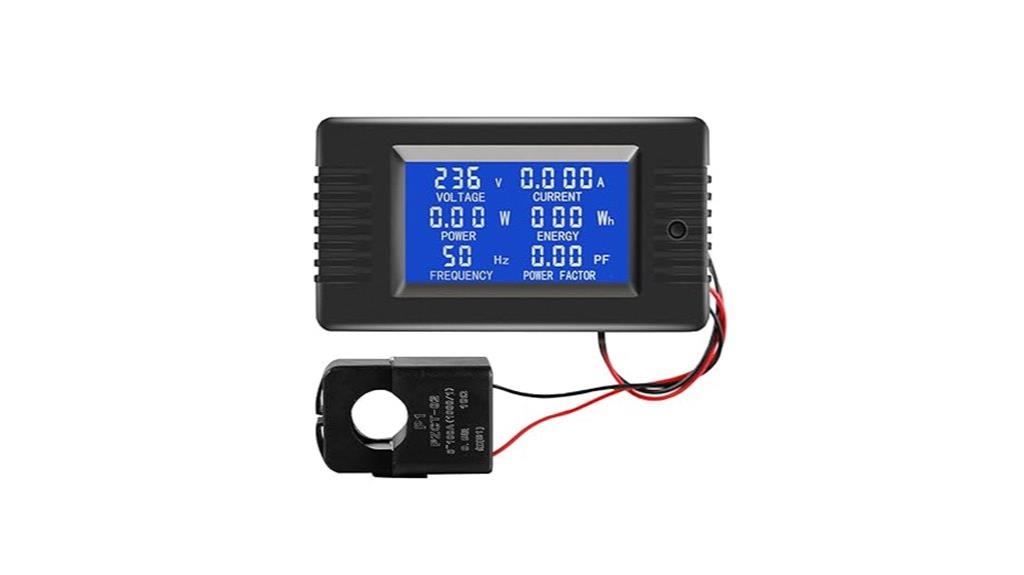
If you’re looking for an affordable, easy-to-install energy monitor that provides real-time insights into your electrical usage, the AC Power Monitor with LCD Display and Split Core Current Transformer is a solid choice. It measures voltage, current, active power, energy, frequency, and power factor simultaneously, with a bright, large LCD display that’s easy to read. The device connects via screw terminals and features a split core CT for simple wiring around existing wires. It’s suitable for monitoring household appliances, heat pumps, or solar arrays, helping prevent breaker trips and optimize energy use. While limited in long-term data storage, it’s highly effective for immediate troubleshooting and daily monitoring.
Best For: DIY enthusiasts, homeowners, and small-scale professionals seeking an affordable, easy-to-install energy monitor for real-time electrical analysis.
Pros:
- Simple installation with split core CTs that do not require wiring disconnection
- Provides comprehensive real-time measurements including voltage, current, power, and energy
- Bright LCD display with adjustable backlight enhances readability in various lighting conditions
Cons:
- Limited long-term data storage and no automatic cost calculations
- Short CT leads may require extension and proper insulation for convenience
- No built-in audible alarms or extensive mounting options, and some software issues reported
Factors to Consider When Choosing an Energy Monitor Whole House

When choosing a whole-house energy monitor, I look at how well it fits my electrical system and the accuracy of its data. I also consider how easy it is to install safely and whether it connects smoothly with other smart devices. Finally, I prioritize real-time monitoring features to stay on top of my energy use at all times.
Compatibility With Electrical Systems
Choosing an energy monitor that’s compatible with your home’s electrical system is essential to guarantee accurate readings and safe operation. First, check if the monitor supports your system type—single-phase, split-phase, or three-phase—since compatibility varies. Next, verify that it matches your panel’s voltage and current ratings, typically from 120V to 600V and 100A to 3000A. Also, ensure the sensors or clamp-ons are suitable for your wiring setup, whether busbar access is available or restricted. It’s important that the device supports your specific wiring configuration, like 2-wire, 3-wire, or 4-wire systems, to ensure proper measurement. Ultimately, confirm whether it can integrate seamlessly with your existing electrical infrastructure, including any additional sensors or modules needed for your system’s complexity.
Monitoring Capabilities and Data Accuracy
Have you ever wondered how accurately your energy monitor tracks your household’s power usage? Accurate monitors deliver real-time data with a precision typically within 1-2%, providing reliable insights. The best devices can measure multiple electrical parameters simultaneously—voltage, current, power, and energy—offering a thorough view of your consumption. High-quality monitors often support detailed data logging and export, making long-term analysis and verification straightforward. To maintain data accuracy, proper installation is essential, including correct sensor placement and calibration. Advanced monitors can identify specific device usage patterns and detect anomalies, helping you target savings more effectively. When choosing a monitor, prioritize those with proven measurement precision and extensive data capabilities to truly understand and optimize your energy use.
Installation Requirements and Safety
Ensuring proper installation is essential for safe and accurate energy monitoring across your home’s electrical system. First, check that the monitor is UL-listed or certified for safety compliance to meet industry standards. Make sure it supports your home’s electrical system type—whether single-phase, split-phase, or three-phase—to ensure proper compatibility. Be aware that installation may require opening your main panel and could involve clamp-on sensors or direct wiring, which might need electrical expertise. Confirm that all components, like current transformers and sensors, are rated for your voltage and amperage levels to prevent overloads or damage. Finally, always follow the manufacturer’s safety guidelines during installation to avoid hazards such as electrical shock, short circuits, or fire risks.
Connectivity and Integration Options
When selecting a whole-house energy monitor, it’s important to contemplate how it connects to your home network and integrates with your existing smart devices. Look for compatible connectivity options like WiFi, Ethernet, or cellular, guaranteeing it fits your setup. Compatibility with platforms such as Google Home, Amazon Alexa, or Home Assistant allows for seamless automation and control. Check if the monitor provides real-time data access through mobile apps or web portals so you can monitor your energy use remotely. Additionally, consider whether it supports data export for advanced analysis or long-term tracking. Security features are essential—prefer monitors that use encrypted data transmission or operate locally-only to protect your household information. These options ensure your energy management system is reliable, secure, and integrated smoothly.
Real-Time Monitoring Features
Real-time monitoring features are essential because they give you instant insights into your home’s energy consumption. With data updates as often as every second when the app is active, I can see exactly how much power each device uses at any moment. This helps me identify high-energy appliances and spot unusual patterns quickly, so I can act fast to reduce waste. Many monitors display live data on voltage, current, power, and overall energy use, giving me a clear picture of my home’s electrical behavior. The ability to receive instant alerts for abnormal activity or spikes helps me stay proactive. Continuous real-time tracking supports smarter decisions, whether balancing loads, optimizing solar energy, or improving overall efficiency. It’s a game-changer for managing energy effectively.
Cost and Budget Considerations
Choosing the right whole-house energy monitor involves balancing your budget with the features you need. Entry-level models can cost as little as $15 to $30, providing basic energy usage data. More advanced systems, with real-time updates, alerts, and integration options, can range from $200 to over $500. Keep in mind that installation costs, especially if professional help is needed for wiring or panel integration, can add to the total expense. When evaluating options, consider whether the monitor’s features justify the price within your budget. It’s important to weigh the monitor’s accuracy, data retention, and support features against your spending capacity. Finding a system that offers good value helps you maximize savings without overspending upfront.
Additional Features and Support
Beyond cost considerations, evaluating an energy monitor’s additional features and support options can substantially impact your overall experience. Features like real-time alerts, customizable notifications, and automation integration make managing energy use more convenient and responsive. Cloud-based data storage and remote access let you monitor your system from anywhere, giving you flexibility and peace of mind. Compatibility with smart home platforms allows seamless control through voice commands or routines, enhancing automation. Advanced capabilities such as peak demand tracking, solar production analysis, and detailed load identification provide deeper insights that help optimize energy savings. Reliable customer support, regular firmware updates, and safety certifications are essential for ongoing performance, security, and compliance. These extras ensure your investment is protected and your energy management system remains effective over time.
Frequently Asked Questions
How Accurate Are Whole-House Energy Monitors in Detecting Individual Device Consumption?
Whole-house energy monitors are quite accurate in detecting overall consumption, but their precision for individual devices varies. I’ve found that some models can distinguish major appliances well, but smaller or similar devices might get mixed up. Factors like installation quality and device signatures impact accuracy. Overall, they give a solid snapshot of your energy use, but don’t rely solely on them for pinpointing every single device’s exact consumption.
Can These Monitors Integrate With Existing Smart Home Systems?
Yes, most whole-house energy monitors can integrate with existing smart home systems. I’ve found that many are compatible with popular platforms like Google Home, Amazon Alexa, and Apple HomeKit. This integration allows me to easily monitor my energy usage through my smart devices, set automation, and receive real-time alerts. Just make sure to check the monitor’s compatibility before purchasing, so it seamlessly fits into your current smart home setup.
What Is the Typical Installation Process for a Whole-House Energy Monitor?
Did you know that installing a whole-house energy monitor can reduce your energy bills by up to 15%? I found the process straightforward. First, I turned off the main power, then mounted the monitor near the breaker panel. I connected the sensors to the main lines, followed the setup instructions, and powered everything back on. It took about an hour, and I was amazed at how quickly I could start tracking my energy use.
Do Energy Monitors Require Ongoing Maintenance or Calibration?
Energy monitors generally don’t need much ongoing maintenance or calibration. I check mine occasionally to verify it’s functioning properly, but most models are designed to stay accurate over time. If I notice any discrepancies or if the device isn’t responding as expected, I follow the manufacturer’s instructions for calibration or troubleshooting. Regular updates or firmware upgrades can also help keep the monitor running smoothly and accurately.
How Can Energy Data Help Reduce My Overall Electricity Bills?
Imagine paying less every month simply by understanding your energy use. That’s how energy data helps—by showing you which appliances consume the most and when. I use this info to adjust habits, turn off unused devices, and schedule high-energy tasks during off-peak hours. It’s like having a personal coach for your electricity bills, making smarter choices that add up to significant savings over time.
Conclusion
Choosing the right whole-house energy monitor can truly transform your energy habits and savings. With so many options, it’s easy to feel overwhelmed—yet, isn’t taking control of your energy use worth it? By understanding your needs and picking a monitor that fits, you’ll boost efficiency and save money in the long run. So, why not start today and make smarter energy choices for your home?
